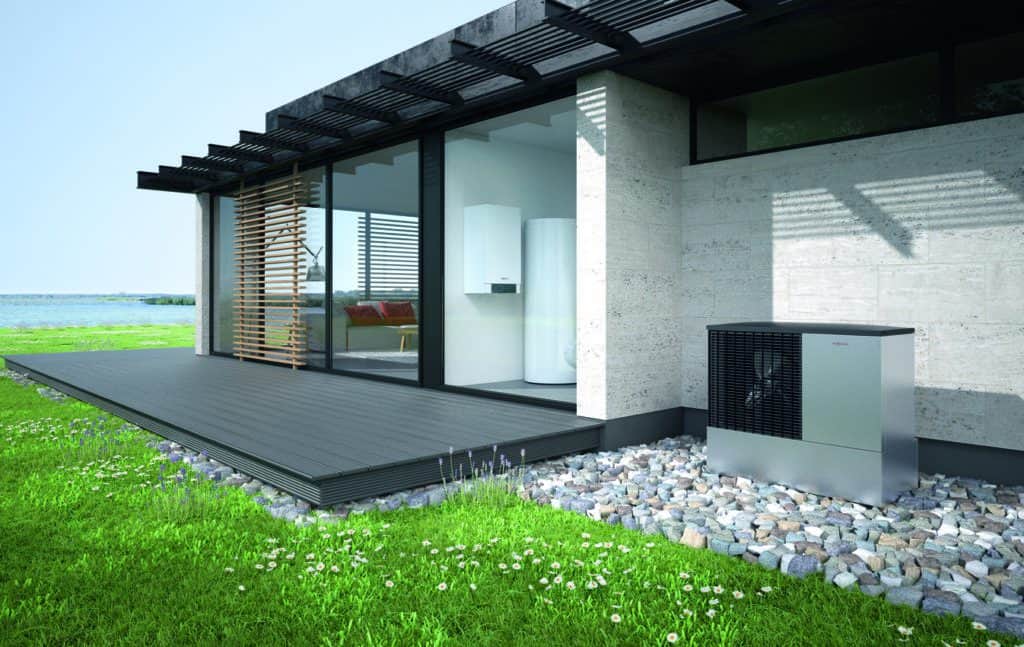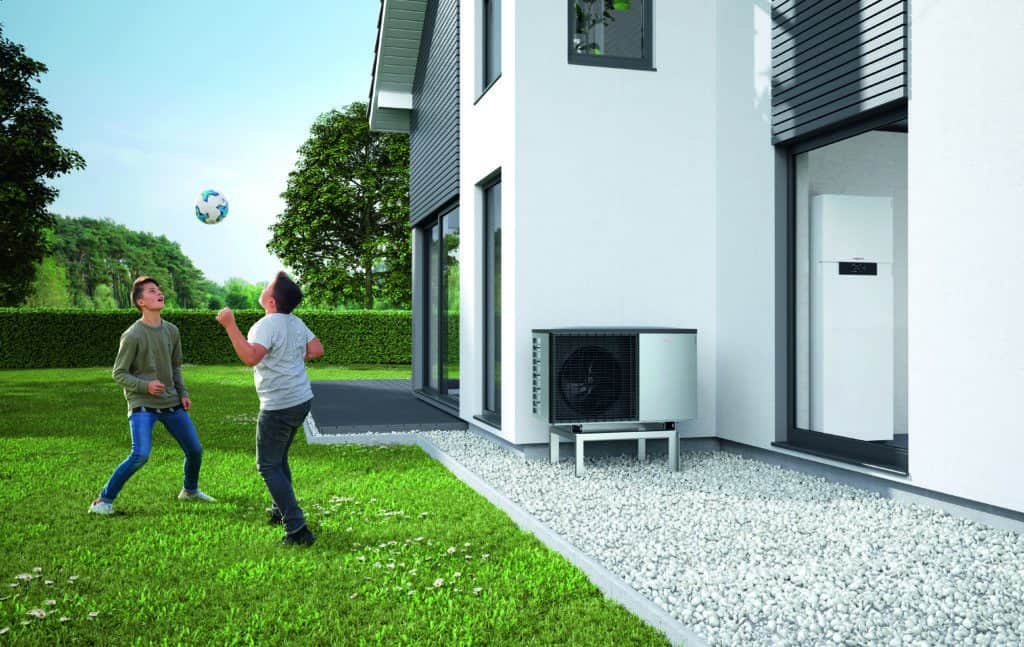Heat Pumps
VIESSMANN
Heat Pumps
CTC
Heat Pumps
Heat Pumps
VIESSMANN
Heat Pumps
made in Germany
![]()
Heating and Cooling with a Heat Pump
Heat pumps enable you to take advantage of renewable energy sources and they can help you to cut your carbon footprint and lower your energy costs. Heat pump technology utilises the latent heat in outdoor air and the ground to provide cost-effective and environmentally responsible heating. These pumps can be used as standalone units or they can be incorporated into your existing heating system as an additional source of heat. In contrast to traditional heating appliances, heat pump systems harness renewable energy from the ground, sun, groundwater, or air. They, therefore, reduce the consumption of fossil fuels, conserving valuable resources in the process. They also lower CO2 emissions that harm the environment.

Heating and Cooling with a Heat Pump
Heat pumps enable you to take advantage of renewable energy sources and they can help you to cut your carbon footprint and lower your energy costs. Heat pump technology utilises the latent heat in outdoor air and the ground to provide cost-effective and environmentally responsible heating. These pumps can be used as standalone units or they can be incorporated into your existing heating system as an additional source of heat. In contrast to traditional heating appliances, heat pump systems harness renewable energy from the ground, sun, groundwater, or air. They, therefore, reduce the consumption of fossil fuels, conserving valuable resources in the process. They also lower CO2 emissions that harm the environment.

How do heat pumps work?
Heat pumps work by taking natural warmth out of the surrounding environment to provide hot water and heating to your home. There are three main types of heat pump: ground source, air source and water source. The name of each one describes where the appliance takes its heat from, and, therefore, each one works in a slightly different way.
How do heat pumps work?
Heat pumps work by taking natural warmth out of the surrounding environment to provide hot water and heating to your home. There are three main types of heat pump: ground source, air source and water source. The name of each one describes where the appliance takes its heat from, and, therefore, each one works in a slightly different way.
1. Absorption
Before anything else can happen, the heat must first be collected. Depending on the type of heat pump, the heat will be absorbed by a refrigerant either from the ground, air or water source. This takes place in the evaporator with the refrigerant changing from liquid to gas in the process.
2. Compression
The refrigerant is now a gas instead of a liquid and the gas is compressed to increase its temperature even more. It is this heat that can be used to warm up your radiators or underfloor heating.
3. Condenser
As the refrigerant transfers the heat that is to be used in your home’s heating system, it gradually cools down and condenses back into a liquid. This occurs in a second heat exchanger. One of the reasons why heat pumps are so efficient is because cooler water from the central heating can continue to absorb the heat from the liquid refrigerant within this second exchanger.
4. Repeat
Once the refrigerant has cooled right down, it passes through an expansion valve. In here, the liquid’s pressure is decreased and it returns to the evaporator to begin the whole cycle again.
1. Absorption
Before anything else can happen, the heat must first be collected. Depending on the type of heat pump, the heat will be absorbed by a refrigerant either from the ground, air or water source. This takes place in the evaporator with the refrigerant changing from liquid to gas in the process.
2. Compression
The refrigerant is now a gas instead of a liquid and the gas is compressed to increase its temperature even more. It is this heat that can be used to warm up your radiators or underfloor heating.
3. Condenser
As the refrigerant transfers the heat that is to be used in your home’s heating system, it gradually cools down and condenses back into a liquid. This occurs in a second heat exchanger. One of the reasons why heat pumps are so efficient is because cooler water from the central heating can continue to absorb the heat from the liquid refrigerant within this second exchanger.
4. Repeat
Once the refrigerant has cooled right down, it passes through an expansion valve. In here, the liquid’s pressure is decreased and it returns to the evaporator to begin the whole cycle again.
How Air Source Heat Pumps Work
In an air source heat pump system, instead of taking the heat from the ground, a fan located outside the property takes in air from outside to heat the refrigerant. The same process is used to heat the solution, turning it into a gas and compressing it. If you have a substantial amount of water around your property, such as a large pond or lake, you may be able to use a water source heat pump to supply your home with hot water. Just like in an air-source system, pipes containing the antifreeze solution can be laid directly in the water source. However, it’s important that the volume of water is large enough. As the solution in the pipes absorbs heat from its environment, the water temperature can drop, causing it to freeze. This shouldn’t happen if the volume of water is big enough for the size of your home. Even if you live in a cold climate, heat pumps can be used when the ground or air is as low as -15 °C.

How Air Source Heat Pumps Work
In an air source heat pump system, instead of taking the heat from the ground, a fan located outside the property takes in air from outside to heat the refrigerant. The same process is used to heat the solution, turning it into a gas and compressing it. If you have a substantial amount of water around your property, such as a large pond or lake, you may be able to use a water source heat pump to supply your home with hot water. Just like in an air-source system, pipes containing the antifreeze solution can be laid directly in the water source. However, it’s important that the volume of water is large enough. As the solution in the pipes absorbs heat from its environment, the water temperature can drop, causing it to freeze. This shouldn’t happen if the volume of water is big enough for the size of your home. Even if you live in a cold climate, heat pumps can be used when the ground or air is as low as -15 °C.


How Ground Source Heat Pumps Work
A ground source heat pump takes its heat from the ground. Pipes are laid under the ground or via a borehole surrounding your home and a solution of water and antifreeze flows through them. It is this solution that transfers the heat from the ground and begins the process above.
How Ground Source Heat Pumps Work
A ground source heat pump takes its heat from the ground. Pipes are laid under the ground or via a borehole surrounding your home and a solution of water and antifreeze flows through them. It is this solution that transfers the heat from the ground and begins the process above.

Ideal for new builds and modernisations
Our heat pumps are highly versatile solutions. They can be ideal whether you are looking for a heating system for a new build or a renovation, and they can be operated in conjunction with solar thermal systems to bring further cost savings and environmental benefits. In addition, they can be combined with an existing gas or oil heating system to form a multi-mode system. This enables every building and property owner to put their plans into action in the most efficient way possible.

Ideal for new builds and modernisations
Our heat pumps are highly versatile solutions. They can be ideal whether you are looking for a heating system for a new build or a renovation, and they can be operated in conjunction with solar thermal systems to bring further cost savings and environmental benefits. In addition, they can be combined with an existing gas or oil heating system to form a multi-mode system. This enables every building and property owner to put their plans into action in the most efficient way possible.


Which is the easiest heat pump to retrofit?
There are two main types of heat pumps – air source and ground source. An air-source heat pump takes in warm air from outside whereas a ground source heat pump takes warmth from the ground. Out of these two systems, an air source heat pump is the easiest to install in an existing home. This is because you shouldn’t require any planning permission prior to installation and the system can be fitted within a couple of days. As previously mentioned, you shouldn’t need any additional pipework or radiators to be installed, unless the suitably qualified heating engineer finds an unforeseen problem with your home’s pipes that may need to be addressed.
The unit for the heat pump can be installed on the outside of your home. This may cause some mess but it should be minimal.
A ground source heat pump is more difficult to install because the pipework needs to be laid in the ground and you may need a certain amount of space to be able to do it. This is why you must have the ground around your home surveyed to ensure that the installation can go ahead. If there isn’t enough space, the pipes can be arranged vertically instead of horizontally, but in order for your heat pump to work efficiently, the pipework may need to go quite a long way down.
Which is the easiest heat pump to retrofit?
There are two main types of heat pumps – air source and ground source. An air-source heat pump takes in warm air from outside whereas a ground source heat pump takes warmth from the ground. Out of these two systems, an air source heat pump is the easiest to install in an existing home. This is because you shouldn’t require any planning permission prior to installation and the system can be fitted within a couple of days. As previously mentioned, you shouldn’t need any additional pipework or radiators to be installed, unless the suitably qualified heating engineer finds an unforeseen problem with your home’s pipes that may need to be addressed.
The unit for the heat pump can be installed on the outside of your home. This may cause some mess but it should be minimal.
A ground source heat pump is more difficult to install because the pipework needs to be laid in the ground and you may need a certain amount of space to be able to do it. This is why you must have the ground around your home surveyed to ensure that the installation can go ahead. If there isn’t enough space, the pipes can be arranged vertically instead of horizontally, but in order for your heat pump to work efficiently, the pipework may need to go quite a long way down.
Heat Pump Retrofit Grants
Retrofit – As of April 2018 the SEAI have made available a grant of €3500 for a heat pump retrofit on any home built before 2011 provided it is considered “heat pump ready”. This will be dependent on the heat loss factor of the house which can be calculated by an SEAI technical advisor. When replacing existing boilers with a heat pump the size of the heat emitters must be carefully considered. Due to the lower temperatures heat pumps operate at some emitter sizes may need to be increased. Where possible UFH could be a retrofit option with products such as our LK EPS16 Insulated Slotted Board.
Who can apply
All homeowners, including landlords, whose homes were built and occupied before 2011 can apply. This is defined as the date your electricity meter was installed. Note that this is different to other grant measures where the home must be built before 2006.
How to apply
- Find out more about how you can apply for a home energy grant
- Ready to apply? Start your application online
Timeframe
You must complete the works and submit the paperwork within 8 months from the date of the grant offer. You can find the expiry date in your offer letter.
Free upgrades for eligible homes
If your home was built and occupied before 2006 and you are in receipt of social welfare payments, you may be eligible for free energy efficiency improvements.
Should you wish to discuss your options for a Viessmann Heat Pump System for a new-build or existing home, feel free to give us a call on
01 809 1571 or email info@phni.co.uk or simply fill out the form below.
Heat Pump Retrofit Grant
Retrofit – As of April 2018 the SEAI have made available a grant of €3500 for a heat pump retrofit on any home built before 2011 provided it is considered “heat pump ready”. This will be dependent on the heat loss factor of the house which can be calculated by an SEAI technical advisor. When replacing existing boilers with a heat pump the size of the heat emitters must be carefully considered. Due to the lower temperatures heat pumps operate at some emitter sizes may need to be increased. Where possible UFH could be a retrofit option with products such as our LK EPS16 Insulated Slotted Board.
Who can apply
All homeowners, including landlords, whose homes were built and occupied before 2011 can apply. This is defined as the date your electricity meter was installed. Note that this is different to other grant measures where the home must be built before 2006.
How to apply
- Find out more about how you can apply for a home energy grant
- Ready to apply? Start your application online
Timeframe
You must complete the works and submit the paperwork within 8 months from the date of the grant offer. You can find the expiry date in your offer letter.
Free upgrades for eligible homes
If your home was built and occupied before 2006 and you are in receipt of social welfare payments, you may be eligible for free energy efficiency improvements.
Should you wish to discuss your options for a Viessmann Heat Pump System for a new-build or existing home, feel free to give us a call on
01 809 1571 or email info@phni.co.uk or simply fill out the form below.


